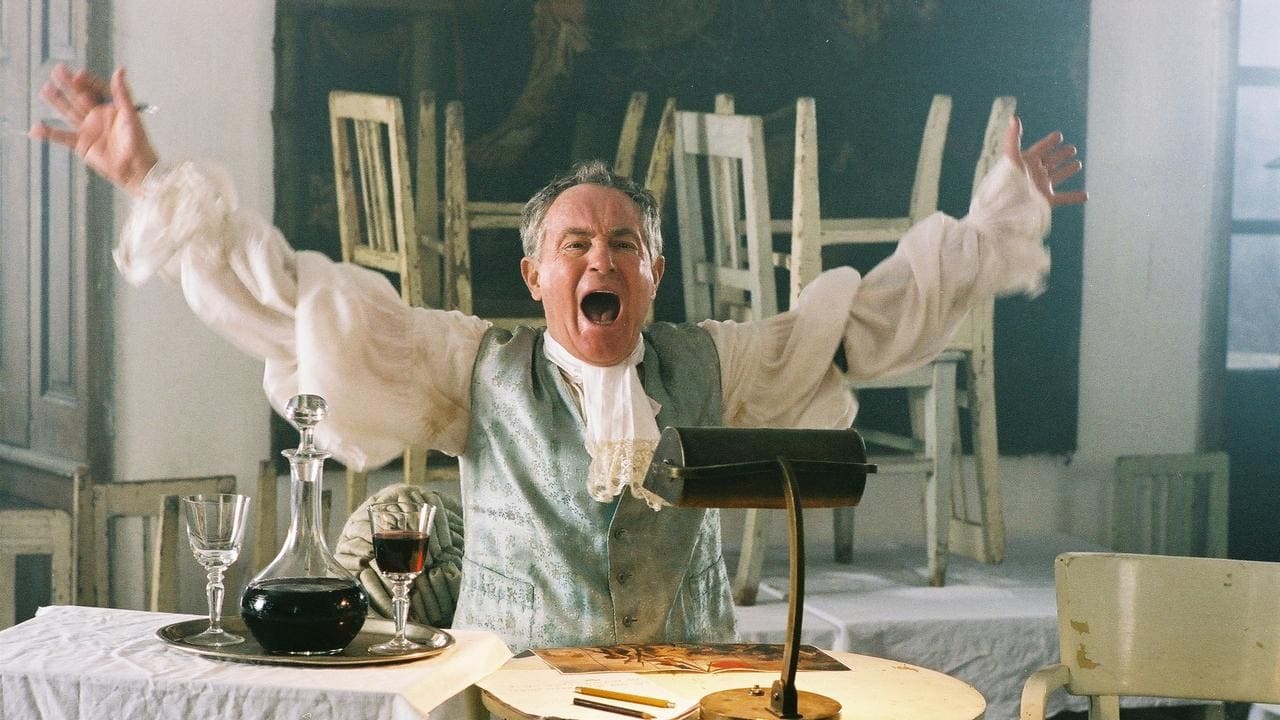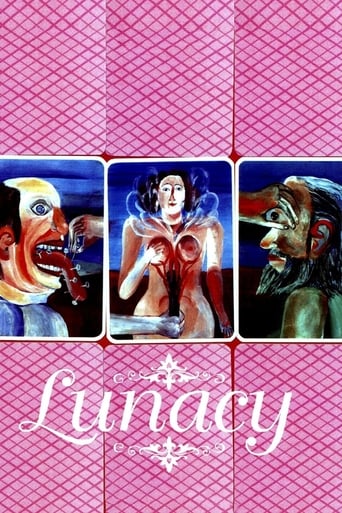Smartorhypo
Highly Overrated But Still Good
Spoonixel
Amateur movie with Big budget
Aedonerre
I gave this film a 9 out of 10, because it was exactly what I expected it to be.
Sharkflei
Your blood may run cold, but you now find yourself pinioned to the story.
framptonhollis
Functioning mainly as a mixture of three demented masters of art (these "heroes" of mine being Edgar Allan Poe, the Marquis de Sade, and Jan Svankmajer), "Lunacy" portrays a world of hopeless depravity. Demented desires are shown to be hidden within those one both extremes of the social spectrum. "Lunacy" is a film that lives up to its title, showcasing a world of idiocy, chaos, and oppression.In his brilliant introduction, Svankmajer claims that this is a film inspired by the works of both Edgar Allan Poe and the Marquis de Sade. Being a fan of both authors, this only further fueled my fascination with the film. Poe's tortured soul often dominates the more melancholic and moody sections of such a masterwork, as well as largely inspiring the overall story. de Sade's sick spirit shines even brighter as Svankmajer displays the perverted sexual acts and desires performed by a common libertine. His surreal lens not flinching one bit, blasphemous rituals of twisted eroticism are performed in a way both chilling and occasionally amusing. Further mirroring de Sade's unconventional brilliance are the nihilistic philosophical musings of the film's own marquis, a man who refuses to hide his perverted desires, hatred for Mother Nature, and disdain for religion. While juggling the atmospheres of ever impending doom and inescapable tragedy, "Lunacy" also manages to be one of the funniest movies of the century so far. Without fail, Svankmajer slyly mocks society using both grotesque horror and riotous black humor. Gags fill up Svankmajer's cinematic canvas like his character of the marquis' sperm does the inside of his sexual victims. Here, hilarity comes in many (often absolutely absurdist) forms, from slapstick to social commentary. Densely layered, Svankmajer's film crowds itself with much comic insanity by the second half. Many sequences work as both scenes of sadistic horror and gross out humor, so never be afraid to burst with laughter despite the urge to spray puke all over the movie screen like a hose.
ray akapotasana
This is a very good film. By now I've seen all the films of Svankmajer, including his early shorts and later long movies. It took me some time to really appreciate his longer films since they are somewhat different from his short movies. For me personally his short films still form the basis of his work and come the closest to art. The lack of a storyline and of a conventional structure rank his shorts among the most original in cinematography. His longer films have a more traditional structure with a storyline. For that reason his longer films didn't appeal the same way to me (as his short films does) for a long time. With 'Sílení' this came to an end. The film starts with Svankmajer himself introducing the film in his own personal nihilistic style. The film itself is a mixture of a 'normal film' with actors and on the other hand the inclusion of disturbing stop motion cinema. Svankmajer's most beloved actors, the cut off Tongues (I believe they are Cow's Tongues) are seen many times, often together in a twin pair depicting scenes of disturbance, violence, sex and in general Lunacy which is the name of the film. The actors are very good, especially the person who plays the Marquise (De Sade). But also Anna Geislerová (who plays the unstable Charlotte) and Pavel Nový (Servant Dominic) (who played a main Character in 'Conspirators of Pleasure' as well) are excellent. In 'Sílení' Svankmajer seemed for the first time to have found a convincing form for his longer films. It's very balanced through out and the film has a constant feel of threat over it. Svankmajer himself introduces his film as a horror movie. And in fact it is, but in a nihilist typically Svankmajer kind of way. The horror element is not about visual shocking effects, but much more psychological since it touches deep human fears. In this perspective I place it in the same row as Polanski's great films 'The Tenant' and 'Repulsion'. The sex scenes give the film an erotic element, although in a deranged way; The theme and story are very original. The film has a pleasant weirdness, but is never cheap like many of the director's who are influenced by Svankmajer. This film get's a 9 from me.
chaos-rampant
A lot of viewers seem to praise Svankmajer for the lunacy of his visual imagination, for the grotesque insides he's willing to lay out. I admit there is stuff worth taking from him, notions I would be interested to engage. But a lot of what he does is so blunt that I mostly want to take a step back, he can be embarrassing to watch, for example here the petulant tirade against god; what kind of god creates only in order to destroy, why doesn't he spare us the pain? Well, precisely the god, meant broadly, the universe that creates again. How selfish, how religiously salvational, exactly the thing he rants against, to think it was all going to last forever!He favors stark allegories, and this is one of the least subtle he has delivered: distinctions between tyranny and freedom as the ways to govern the world madhouse. We see one, then the other, always with an eye on the world at large, or so it goes.There is one interesting bit in all this, a clever staging; a tableaux vivant that recreates Delacroix's 'Liberty', where inmates who are ostensibly free to be as creatively mad as they want are marshaled into position as living props. During the stageshow later, one of them actually attacks in a fit of lust the woman portraying liberty. Of course unbound freedom can spawn its own despots, we're meant to take this lesson ambiguously.It's all wrapped in Poe; 'Premature Burial' as backstory attached to de Sade, a pendulum shot, the main thrust is from 'Doctor Tarr and Professor Fether'. And there is an experimental short woven through the film, typical Svankmajer stuff that he does best about animated slabs of meat trying to enter the narrative, or substituting for insights that can't be articulated there.But it's never quite as erudite as it would like to be. The final image is unremittingly blunt; modern man as another slab of meat in a long row, a prepackaged exhibit suffocating in his modern cellophane wrap. I suggest you watch instead The Hourglass Sanatorium, another Eastern European film about a damaged man mingling with madness in an effort to restore in him parts missing - the quest in both is for subconscious images of a parent. But that film unswathed in a dozen different layers, offering on the whole the purely symbolic construct of a graven image, but as a space of metaphysical contemplation on the placement of the soul in the cosmic grind. Here, it's one allegory broken out in so many authoritarian asides.
lemuel-kolkava
The Lunatics I attended the Slovak premiere (February 22nd) of Jan Svankmajer's latest cinematic work, the movie called Lunatics (Šílení). Jan Svankmajer, the famed surrealist artist/animator/filmmaker is back in full force with a generic horror film with "all the deficiencies the genre entails". Though the movie is mainly live actors it contains the trademark surreal animations you would come to expect from Svankmajer. These animations (crawling flesh, rolling eyeballs, bovine tongues dancing in beer glasses, you name it, it's there) cut in between scenes fulfill the role of visual music and help illustrate the progress of madness on screen.Svankmajer's intro really says it all; this philosophical horror movie is "an infantile homage to the writings of Edgar Alan Poe" with "a few subversive ideas borrowed from Marquis de Sade". The movie's basic premise concerns the great ideological dispute of how best to run a lunatic asylum – on the one hand you have the concept of total freedom and on the other the conservative ideal of discipline and punishment. According to Svankmajer there is a third way that manages to combine all the negative aspects of these two approaches and it is the reality we live in...The movie starts a bit slowly, the pacing is really uneven and could have used a bit of editing, but then Svankmajer wouldn't have been able to let the Marquis (the impeccable Jan Triska) recite director's favourite "blasphemous" passages from de Sade. Anyway the young hero Berlot suffers from live nightmares (in which lunatic asylum workers try to put him in a straight jacket) that end in destruction of all furniture around him; he befriends the Marquis who pays for the damage in the inn where Berlot spend the night on his way from his mother's funeral. After Berlot witnesses Marquise's libertine ways, sadomasochistic orgies, blasphemies, cataleptic shock and a live burial he is nonplussed enough to be convinced by Marquis that the best way to face his own fears of lunatic asylum is to submit himself to one, run by Marquise's friend Dr. Murlloppe. In the asylum run according to the principles of absolute freedom (patients running around with scissors, bobsledding down the stairs etc) he meets the girl who involuntary took part in Marquise's sex orgies and she tells him that Marquise and Dr. Murlloppe were patients in the asylum as well but led a revolt against the reign of the psychiatrist Dr. Coulmiere (great Slovak actor Martin Huba), who remains trapped in the asylum's basement along with his staff... At this point the movie has griped you and doesn't let go until the predictable but great end. All in all, this is a great horror movie, if by horror you mean a bizarre and surreal grotesque... you will laugh and marvel and think, because this is the type of a movie that allows you to do just that.9/10.

